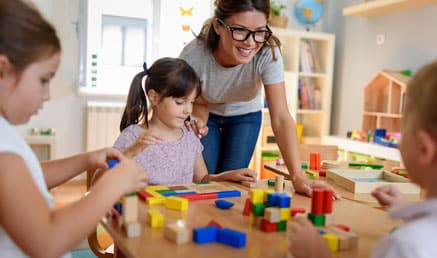
“It’s our polite nudge in the ribs to help you and your team stay organised and on task.”
This week’s subject: Continuity of learning and transitions
Element 6.2.1: Continuity of learning and transitions for each child are supported by sharing information and clarifying responsibilities
How does your service strategically plan to support smooth transitions for children and families?
Transitions include periods where children move and adjust to different spaces and environments with different people, routines, experiences, settings and expectations. The key to an effective and smooth transition is where children and their families, no matter what your local context may be, feel secure, accepted, supported, prepared, positive and familiar with the new environment they are transitioning into.
Throughout the year, Services are planning for and implementing strategies to support children and their families through a variety of transitions, whether it be starting at a new service, transitioning from home to their first ECEC Service, transitioning to a new room, daily transitions throughout the routine, transitioning from an ECEC setting to formal schooling and school age care.
Consider some of the following strategies when supporting children to transition between daily activities and routines:
-
- Ensure children are, at all times, aware of what’s happening and what steps/routines are to follow
- Ensure children are given warning prior to transitions as they’ll traditionally transition more effectively and confidently when they’re prepared and prewarned
- Assess your physical environment and resources, does it support children to transition with ease?
- Ensure consistency with routines and transitions from all educators to ensure children know what to expect.
- Minimise gaps and wait times between transitions to reduce the likelihood of disruptive behaviours.
- Staggering transitions to minimise wait times so that smaller groups are transitioning at any given time.
- Ensure educators role model the desired behaviour, remaining & speaking calmly when leading transitions.
- Plan your daily routine with minimal transitions to support a smooth and seamless flow to the day.
Consider some of the following strategies as part of your plan to support children/families when starting at a new service:
-
- Provide a tour and induction of the Service and routines, for the child and their family prior to the child’s first day of care.
- Allocate a key educator to each new child and organise your rosters to ensure they are available to support the child each morning that the child attends the service.
- Include a learning story in the enrolment pack which includes a photo and an introduction to the key educator as well as an introduction to the educators in the child’s allocated room. The story should include details of the process of being dropped off at the service and saying “goodbye” to their parent/guardian.
- Ensure that educators are available during arrival and departure times to welcome and farewell children and their families. It’s a good idea to have additional educators available during these times, particularly at the start of a new year when many children are starting at new services.
- Use the information provided by families about the child’s interests and have these resources/experiences readily available when they arrive at the service.
- Provide families with an update on how their child has settled during the day for their first few days/weeks to support them to feel at ease.
- Consider implementing a buddy system, partnering an older child with a younger child to help support them when starting at the service (school age care)
Consider some of the following strategies as part of your plan to support children when transitioning to a new room:
-
- Schedule orientation visits to the new room to allow the child to become familiar with the educators and the new environment.
- Implement the transition slowly and increasingly over time, allowing the child to spend some time in their new room gradually before moving them on a full-time basis.
- When grouping children at the start and end of the day, utilise different rooms at the service so that children are used to being educated and cared for in other learning environments at the service.
Consider some of the following strategies as part of your plan to support children when transitioning to school and school age care:
-
- Encourage children’s self-help skills to aid in building confidence in their transition to new routines and tasks. i.e. practice tying laces, packing/unpacking their bags, opening/closing lunch boxes/drink bottles etc.
- For Services providing meals- In the latter part of the year, have children practice bringing their lunch in a lunchbox. Encourage and support children to open/close lunchboxes and packaging. Ensure you provide families with information of the purpose and benefits of this practice in preparing children for school.
- Consider planning visits to the local/feeder primary schools.
- Share information with families about strategies to implement at home to help prepare their child for school (see “resources for families” below).
- Create and display a visual “starting school countdown” calendar for children to refer to at the Service or to take home
- Encourage and support children to use the toilet independently, including dressing themselves during/following toileting.
- Implement a range of experiences/activities that help to build children’s core strength and postural control. It’s important that children develop their core strength as they will likely spend extended periods of time sitting on the floor, with legs crossed in the school/classroom setting. This can physically exhaust children very quickly, result in poor posture and impact their ability concentrate as well as lead to other challenges within the classroom. Importance of core strength in children
Resources for Services:
Plan Effective Transitions for Children (In ECEC services)
The Spoke- One day of little transitions
School readiness preparation tasks/activities- for educators and parents
Strategies to help children transition through their day
Transition to school- A collaborative effort
Importance of core strength in children
Resources for families:
Starting Blocks- Information for families
Transitioning to primary school
Parent’s guide-Getting ready for primary school
School readiness preparation tasks/activities- for educators and parents
Within System7 go to Quality Area 6/ Modules 14, 15, 16 & 17 to submit self-assessment notes and if required, open a QIP issue if you identify any areas of improvement.
The Childcare Centre Desktop has a range of resources to assist services with transitions. These include Transition to School Guide, Transition to New Room Letter, Transition to School Statement, Transition to School Resources for Educators and much more.
Resources, NQS Element, Regulation and System7 links:
Childcare Centre Desktop – Childcare Centre Desktop
National Quality Standard – QA 6/ 6.2.1- Transitions
National Regulations – 75, 76, 155, 156, 157, 168
System7 Module – QA 6/ Modules 14, 15, 16 & 17
If you have any questions send us a note via the Contact page here!




